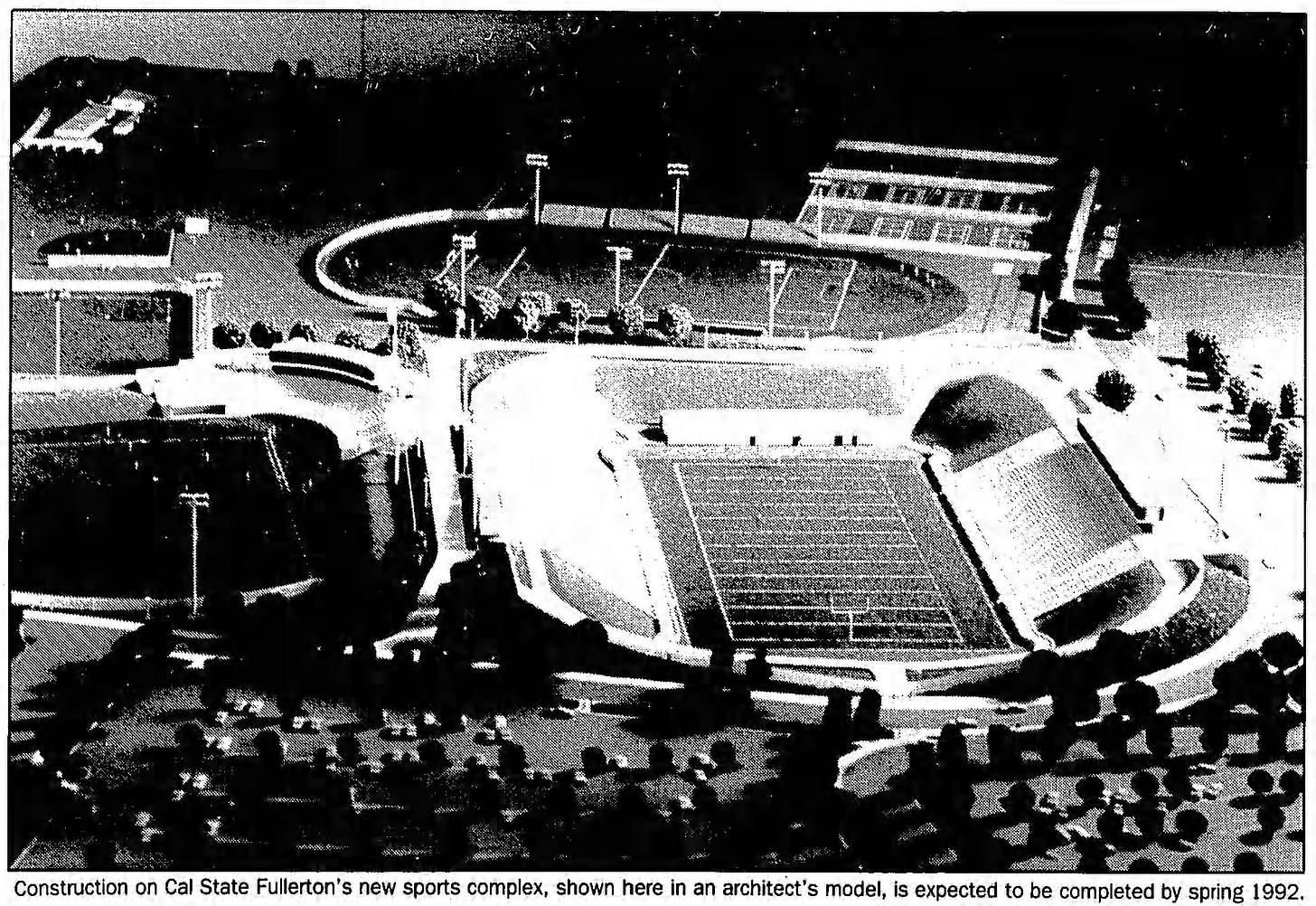This series reviews the program history and stadium sizes of colleges that dropped or deemphasized football. Click here for the series introduction. The schools included in the review are listed below.
California State University, Fullerton

A number of the schools profiled in this series started playing football in the 1890s or earlier. California State University, Fullerton, is not one of those. The community of Fullerton, California, which sits immediately north of Anaheim in northern Orange County, was little more than a train station and orange groves when founded in 1887.
The massive population growth in the Los Angeles area post-WWII led to the growth of Fullerton and surrounding communities. In turn, the state legislature approved the founding of Orange County State College in Fullerton, which opened in 1957. It underwent several name changes until settling on California State University, Fullerton (CSUF) in 1972.
The student government petitioned the school to start a football program in 1965, and the school agreed, setting aside startup money for several years before the program kicked off for the first time in 1970 when CSUF had 11,000 students. (It now enrolls 41,000.)
From the beginning, the program was cash-strapped and, lacking a home field, played games at Santa Ana Stadium, a municipal stadium 30 minutes from campus, Anaheim Stadium, the LA Coliseum, and Falcon Stadium at Cerritos College, a nearby junior college. Besides playing the usual buy games as the visiting team at high-level programs, CSUF also gave up some conference home games at times since they could earn more money taking the visitors’ portion of the gate at conference competitors’ stadiums versus hosting home games, largely played off campus anyway. The promise of building a home stadium and athletic complex was dangled before prospective coaches but did not materialize.
Gene Murphy became the CSUF’s fourth coach in 1980 and, determined to have a home field, used the football team’s labor to establish an on-campus stadium using temporary bleachers borrowed from the Long Beach Grand Prix. That lasted two years before the team returned to Santa Ana Stadium. Despite limited scholarships and other money, Murphy’s best team came in 1984 when they went 12-0, including a game UNLV won on the field but later forfeited for using ineligible players.
Challenges in raising money for the athletic complex continued. However, sufficient money finally became available in 1990 to contract for the football stadium and athletic complex (as seen in the image above). The stadium did not open until 1992, with plans reduced by then, so the new field did not have locker rooms or benches for the visiting side stands. Those spectators sat directly on the cement.

Due to a California State University system-wide budget crunch, the system offered early retirement packages to employees in the fall of 1992. Thirteen-year head coach Gene Murphy accepted the package and announced his season-end retirement before the fifth game. The team finished 2-9, giving them five victories in the last three seasons.
Continued financial challenges and limited attendance numbers led the school to drop football after the 1992 season. While administrators suggested they would bring the program back in several years at the FCS level, they never did.
Despite an athletic department that has won multiple NCAA baseball championships, the school could not make football a go and avoided the Concorde Fallacy by dropping the program within months of opening its stadium.
Over its twenty-three years, the program produced 22 NFL players, and a host of coaches worked in the program who went on to successful college and pro careers, Steve Mariucci being the most well-known.
2024 Concept Uniform
My brother, Steve, dabbles in sports team logos and uniforms. Here are his concept uniforms for CSUF’s imaginary 2024 team.
Next up: Marquette
Below are the schools reviewed to date, ranked by stadium size. The stadiums’ opening and demolition years (if applicable) are also noted.
Catholic (Brookland Stadium): 30,000 | 1924 - 1985
Denver (DU/Hilltop Stadium): 30,000 | 1925 - 1971
Marquette (Marquette Stadium): 24,000 | 1924 - 1977
Xavier (Corcoran Stadium): 15,000 | 1929 - 1988
Gonzaga (Gonzaga Stadium): 12,000 | 1922 - 1949
California State University, Fullerton (Titan Stadium): 10,000 | 1992 - TBD
Boston University (Nickerson Field): 10,000 | 1915 - TBD
Vermont (Centennial Field): 10,000 | 1923 - TBD
NYU (Ohio Field): 5,000 (est.) | 1897 - 1947
San Francisco (St. Ignatius Stadium): <5,000 (est.) | c. 1909 - c. 1930
Carnegie-Mellon (Skibo Bowl): 4,500 | 1960 - 1987 | Gesling Stadium: 3,900 | 1990 - TBD
Sewanee (McGee Field): 3,000 | 1891 - TBD
Schools to Review
California State University, Long Beach | University of California, Santa Barbara | Case Western | Chicago | CCNY | Creighton | DePaul | Detroit | Drake | Loyola (Chicago) | Nebraska-Omaha | Pacific | St. Louis | Santa Clara | Tampa | Washington University in St. Louis | Wichita State
Football Archaeology is reader-supported. Click here to buy one of my books or otherwise support the site.





I attended a couple of soccer games at Titan Stadium to watch my Cal Bears face off against CSUF, which was basically my backyard at the time.